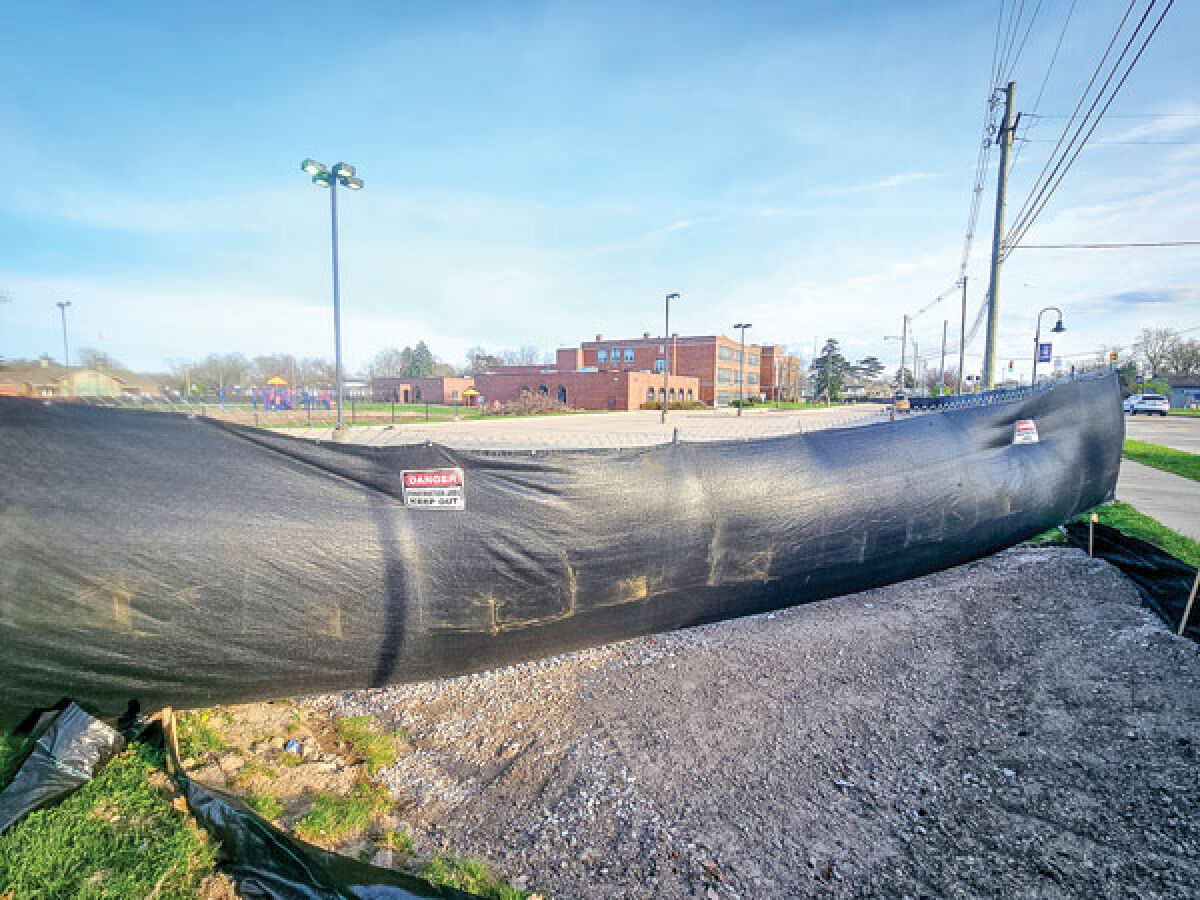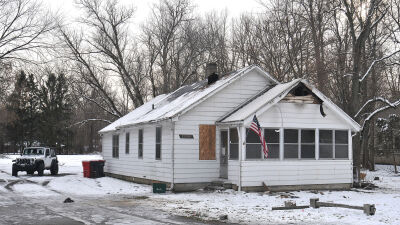KEEGO HARBOR — Residents continue to persevere in their fight to save Roosevelt Elementary School, which prior to closing in 2022 was the longest continuously operating school building in Oakland County and is more than 100 years old.
Last September, in a 5-2 vote, the West Bloomfield School District Board of Education members passed a recommendation to demolish the Roosevelt building and playground.
In a 4-2 vote last month, demolition and abatement bids were approved.
Following that meeting, attorneys for a community group announced that an injunction had been filed in Oakland County Circuit Court. The Heart of the Lakes Community Inc. community group was listed as the plaintiffs, and the West Bloomfield School District was listed as defendants.
Board of Education President Stacy Brickman and Vice President Nelson Hersh, and members Julie Beaty, Ashleigh Davis and Wm. Art Holdsworth voted to approve the recommendation to demolish Roosevelt and its playground.
Board of Education members Deborah Evans and Carol Finkelstein voted against the recommendations.
The plaintiffs secured a temporary victory when it was announced that Sixth Circuit Court Judge Phyllis McMillen had issued a temporary restraining order to stop the district from demolishing Roosevelt.
However, earlier this month, the Heart of the Lakes Community had its attempt to secure a permanent injunction to protect Roosevelt from demolition denied.
The nonprofit then filed an emergency motion for stay, pending appeal.
The court granted a temporary stay April 16, “effectively pausing any plans for abatement or demolition for 14 days,” according to a press release.
“The Heart of the Lakes Community has received a beacon of hope in the fight to preserve the historic Roosevelt building,” the release states. “This important decision allows us the opportunity to appeal to the higher court. … The judge’s decision to grant a stay acknowledges the building’s irreplaceable role in our community and provides a glimmer of hope in what has been a daunting journey.”
Keego Planning Commission member David Emerling has been at the forefront of efforts to save Roosevelt.
“We’re fighting still, tooth and nail, to try to get this building to stay up,” Emerling said. “We’re not giving up.”
Although Heart of the Lakes was given 14 days to try to convince the Court of Appeals that the previous decision was wrong, unless Board of Education members reverse their own previous decision, from the perspective of Timothy Mullins, who is an attorney representing the school district on behalf of Giarmarco, Mullins & Horton P.C., the Roosevelt building is still set to be demolished.
“That’s what I think, and that’s what the judge very clearly declared,” Mullins said. “So, they’ve got 14 days to try to convince the Court of Appeals that she was wrong in her opinion.”
Mullins shared a potential timeline for how things might play out following the 14-day time period that was granted.
“Once the asbestos is taken out of the building, the purpose being that demolition doesn’t release asbestos anywhere, then the demolition will go forward after that,” he said. “So, you’re looking at 14 days – add 30 days period of time there for the asbestos abatement to be completed – and then demolition is set to go forward after that. … The bottom line is that under our law in Michigan … the law says a school district is run by the Board of Education and the … school district is given the power to buy, sell, build, tear down (and) modify school buildings.”
With the Board of Education approving a recommendation to demolish Roosevelt last September, Mullins doesn’t believe that there is a legal basis to prevent demolition from happening, given all the time that has passed since that decision was made.
“As the court pointed out, if this is a matter of such great urgency and you think the school district is in any way acting inappropriately, relative to any applicable law, where were you then? The law says after 60 days a decision by the board conducted in an Open Meetings Act is final,” Mullins said. “The lawsuit they filed is based on supposed violations of the Open Meetings Act. Well … all of this period of time has gone by, so it’s too late to even raise the issue.”
The issue has received both local and national attention, with the Wall Street Journal recently publishing an article about it.
Prior to the Board of Education meeting last March, it was revealed that JSN Architecture, located in Berkley, had expressed an interest in purchasing the building for $1.7 million.
During the public comments portion of that meeting, some speakers tried to convince Board of Education members that they need not fear Roosevelt becoming a charter school, which could take per-pupil dollars from the district.
Noah Arbit, who is the representative for state House District 20, sponsored House Bill 5025 with the intent of repealing Public Act 98, which prevents deed restrictions from being included on properties sold by public schools.
Arbit spoke during the public comments section of last month’s meeting and asked board members to “pump the brakes” on the decision to demolish Roosevelt, allowing time for his bill to potentially pass.
Oakland County Commissioners Bob Hoffman and Kristen Nelson, along with Keego Mayor Rob Kalman and multiple residents also made public comments in opposition to the demolition of Roosevelt.
Joseph S. Novitsky, of JSN Architecture, said during public comments that the firm wants to turn the school into an apartment building.
At the meeting, Emerling pointed out that the firm wants to convert the classrooms to apartments, but leave common areas to the community.
From the perspective of Keego resident Kirsten Douglass, the district should “sell the piece of property, be fiscally responsible, and listen to your constituents.”
“We’ve tried to partner with them,” Douglass said in an interview with the Beacon. “Every concern that they had, we offered a solution. I don’t understand the secrecy; I don’t understand the lack of transparency.”
Keego resident Marilyn Svaluto is of the opinion that the district is “totally dismissing us.”
“Why take a resource, a beautiful, noble, historically valuable building and turn it into a landfill?” said Svaluto, who said that she is a retired public educator. “Nobody will give us an answer why. That’s the real rub for me. … I know several historical societies in and around Oakland County have … asked that it not be demolished.”
When it comes to the decision to demolish Roosevelt, the question of “why?” has been a theme among Keego residents.
“We don’t want (them) to demolish until they’ve looked at all the options, and we can’t figure out why they won’t,” Svaluto said. “It’s bizarre. Why won’t they look at a viable option to buy the building for $1.7 million, get it off their rolls (and) bring in revenue to the city?”
Douglass also posed a question.
“You have a $1.7 million offer, which will net you, I believe, it’s $2.2 million in profit because you’re not spending the $600,000-plus for abatement and demolition,” Douglass said. “Why wouldn’t you even consider that?”
Emerling said that he is baffled that the situation has gone this far.
“The Wall Street Journal came out, and now it’s national attention, and every single news article and newscast makes the district look poor,” he said. “And then the Wall Street Journal pointed out … that their test scores are going down. Now that’s national news.”
Emerling said that fencing that has gone up around Roosevelt has made residents “very upset and distraught.”
“But they just aren’t listening to the people that voted for (them),” he said. “There is no logical reason why they’re doing what they’re doing. I have no idea what the hurry is.”
Emerling said that Keego’s population, according to the last census, is 2,700 people. He is of the opinion that with West Bloomfield residents making up the vast majority of the population in the district, Board of Education members would not vote to have a school demolished if residents in that community pushed against it.
“We voted, I believe 80% or 90% against the last millage, Keego Harbor did, and … it still passed because the majority of the voters are in West Bloomfield,” Emerling said. “I think if their voting base was against something that they were doing they would listen a little bit more than they do when it comes from Keego Harbor residents.”
Between a redistricting plan that is splitting up students and the decision to demolish Roosevelt, according to Emerling, the procedure for how to switch school districts is being investigated.
“To take 90 kids and split (them) into two elementary schools … why couldn’t they (have) just made all the kids go to one school? So when you take that, and then you take what they’re doing to our historic school, it becomes like, ‘Why do we keep getting treated this way out of a district when they take our tax dollars?’ Over 35% of my tax that I pay in property taxes goes to the district, and they treat us that way,” Emerling said. “They don’t treat us like they appreciate our money.”
Although Emerling made it clear that he is not speaking for anybody else, the other districts that he mentioned as possibilities should Keego split from the West Bloomfield School District are Bloomfield Hills and Waterford.
In the meantime, the fight to save Roosevelt continues.
“We’re getting support from all over the country,” Emerling said. “We started a GoFundMe page (www.gofundme.com/f/save-roosevelt) to help with our legal fees. … I think this has gone on way too long for them. It’s causing damage.”
According to Mullins, there is not an immediate plan to build anything on the land after a potential demolition.
“The short answer … demolition, retain the land, save it for future use for the school district as needed,” he said.
 Publication select ▼
Publication select ▼

























